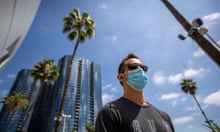The age profile of new infections in the coronavirus pandemic appears to be younger following resurgences in countries such as the United States, Israel and Portugal linked to greater social contact among under 40s following the loosening of restrictions.
The trend has been most marked in the US and noted by scientists at the World Health Organization, who have also seen infections of younger people in the developing world contributing to the shifting demographics.
Data from the US in recent days, in particular from Florida, Texas and Arizona, has shown a sharp increase in cases among the under-40 age group in comparison with early phases of the pandemic blamed by experts on so called “second wave behaviour” as younger age groups – who see themselves as less likely to contract a severe case of the disease – have let down their guard.
The apparent changes in the age profile of those contracting the disease has led to concerns that more relaxed attitudes among younger age groups towards physical distancing may be a key factor in driving second peaks through the kind of parties and beach visits recently seen in the UK and elsewhere.
That fear was echoed by Benjamin Wakefield, a research associate at Chatham House’s global health programme. “There is a danger that positive steps may encourage a shift in public attitudes toward the pandemic, such as the threat being taken less seriously or thinking the pandemic is over,” he said. “This attitude is evident already from those flouting social distancing measures at beaches, parks, and even illegal raves.”
While some of the change can be explained by better and more extensive testing picking up more mild cases, other experts suggest that while older age groups have remained more cautious about shielding that has not been reflected in the behaviour of younger people.
Oliver Morgan, one of the World Health Organization’s directors of health emergency involved in the epidemiology of the outbreak, told the Guardian that there were questions to be asked about whether appropriate public health messages were reaching the right target groups. “All outbreaks of disease have significant social components for how they are controlled and stopped,” he said, adding that young people needed to be engaged with in the fight against coronavirus. “The public health approach needs to be relevant for them as an important group that has seen interruptions in education, schooling, university and work.”
Despite most of the concern in recent days being focussed on the developed world, experts are also increasingly concerned what infections of younger people in the world’s poorest countries might portend, not least those already weakened by other diseases like malaria, HIV and diarrhoea.
According to recent figures in the US, cases have been climbing quickly among young adults in states where bars, stores and restaurants have reopened.
Robert Redfield, the director of the US Centers for Disease Control and Prevention, is among those suggesting that younger people have helped fuel the increase in known coronavirus infections — while also suggesting that many of those infections may have gone undiagnosed earlier in the outbreak.
“Our best estimate right now is that for every case that was reported, there actually were 10 other infections,” he said.
“The virus hasn’t changed. We have changed our behaviours,” Ali Mokdad, a professor of health metrics sciences at the University of Washington in Seattle told the Associated Press earlier this week. Younger people are more likely to be out and taking a risk.”
A case in point has been Florida, where those in 15-to-34 age group now make up 31% of all new cases, a rise of 6% since the early weeks of June. That has also seen median age for new Covid-19 patients in Florida fall from 55 years in March to under 35 in June.
Arizona has seen a similar trend. While in late March 40% of cases were among people under 45, that figure has now risen to 60%.
Even though the rise in diagnosed infections in US states and Israel – which has also seen a sharp resurgence since beaches were thronged for the Shavuot holiday – is among younger people, experts are concerned that wider levels of infection will inevitably lead to more deaths in older and more vulnerable populations.
That issue was addressed by Florian Krammer, a professor of microbiology at Icahn School of Medicine in New York in a lengthy Twitter thread related to the relationship between increased infections among younger cohorts and later increased mortality in the wider population.
Krammer pointed to data from a second peak that occurred in Iran where cases began to increase again from around 1 May and its implication for the US.
“It starts to go up around May 1st again. But deaths did not go up. People explained to me, that now mostly young people are getting infected so nothing bad would happen.
“So here is the graph for the deaths. That [graph] started to rise again around May 25th. This is a solid 3-4 week delay. What happened? First, it takes time to die of Covid-19. Second, cases probably really built up in younger people.
“But they diffuse into older populations. And then the deaths rose (both graphs below ). Surely everybody ... would agree that we need to do better than Iran. But looking at what happens in the US, I am not optimistic.”
That dynamic was also echoed by Dr Robert Phillips, chief physician executive of Houston methodist hospital in a recent interview with AP commenting that while some younger cases were “sick enough” to be hospitalised, they have not been “quite as sick” as those in more vulnerable age groups.
He added that he still found the trend disturbing because young people “definitely interact with their parents and grandparents,” who could be next.







